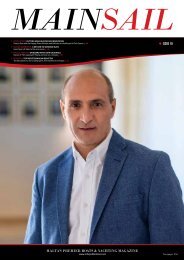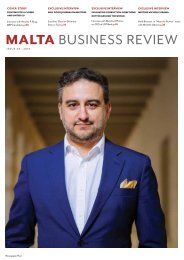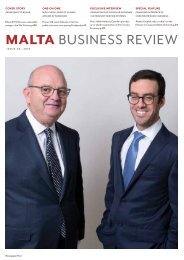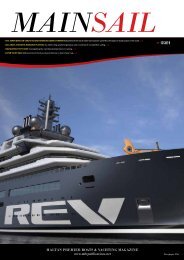You also want an ePaper? Increase the reach of your titles
YUMPU automatically turns print PDFs into web optimized ePapers that Google loves.
FASHION INTERVIEW<br />
slogans about politics when the structure of your brand<br />
is not going towards the effectiveness of that meaning.<br />
For example, I don’t see anyone designing anything<br />
that’s feminist. I see everyone saying it, but I don’t<br />
see any products being made. I just see people<br />
regurgitating designs that aren’t feminist. That’s where<br />
the giant bra in my collection came from: accentuating<br />
a woman’s anatomy. I felt that was the most political<br />
statement I made in this collection. I don’t really feel<br />
like I have any solutions to the problem of politics<br />
and fashion, so for the time being my standard is to<br />
be at a minimum. It’s good to take a moment and do<br />
something that feels standard, so that you know and<br />
understand what’s frivolous in a social way.<br />
<strong>ST</strong>: Is this also why you came back to tailoring,<br />
at a time when everyone else is jumping on<br />
the streetwear bandwagon?<br />
SO: Yes, we’re at a moment where you wonder, “Are<br />
you into streetwear because you’re favouring the new<br />
and the next, or just because that’s where the money’s<br />
going? Do you really believe in the idea of diversity in<br />
fashion?” Today everyone is becoming a brand, there<br />
are no more designers. I don’t think that’s a problem,<br />
but I just think that you can’t call things fashion when<br />
there are no designers. No one is saying, “This is what<br />
I designed this season, you can buy into it.” It’s the<br />
other way around: “Look what I’m implementing into<br />
these criteria, buy into this because this is actually<br />
just a brand.” People forget that the aesthetics that<br />
someone created are for a reason, and if you don’t<br />
like it then you shouldn’t be buying the brand in<br />
general. That’s why ever yone adapting streetwear<br />
feels inorganic and cheap. I don’t see anyone doing<br />
it in a demanding, highbrow way. They know what it<br />
looks like, but they don’t really understand it. Right<br />
now streetwear is no cooler than it was in the 90s<br />
when people were actually wearing it. I don’t see<br />
anyone taking it to the next level, except a few specific<br />
designers. So in my collection for Helmut Lang, it was<br />
all about keeping it in the tailored world. Yes you can<br />
buy a T-shirt and hoodies, but I don’t even think it was<br />
necessary to show them on the runway. And most of<br />
the brands that adapt streetwear today shouldn’t be<br />
showing it on the runway either: they don’t have the<br />
precision that makes it important.<br />
<strong>ST</strong>: And what about all the Helmut Lang logos<br />
you played with?<br />
SO: There was so much to play with! But everyone has<br />
referenced Helmut Lang so much, including myself. At<br />
some point, for example, we wanted to reference his<br />
Mapplethorpe vibe, but realized it looked like a collection<br />
that Raf Simons did before. So we just chose to do the<br />
most basic things, rewriting Helmut Lang’s name like a<br />
little child. Very primary things seemed to be the point.<br />
“When you are a young designer taking over a house<br />
that was created by one of the great names of couture,<br />
you really have to be strong.”<br />
<strong>ST</strong>: Helmut Lang’s current structure is quite<br />
experimental, with an editor in residence,<br />
Isabella Burley, and guest designers. Do you<br />
feel this is relevant?<br />
SO: Yes. It was interesting for me to take the risk of<br />
doing something that hasn’t been done, but with<br />
someone else’s project. It was good to be there at<br />
the beginning. In the future it will be great if it really<br />
goes into this idea of curation. Isabella has done great<br />
examples of that with the capsule collection that<br />
recreates pieces by Helmut Lang, and I think other<br />
brands will start to do their own version of this. Isabella<br />
is smart enough to keep it going in a good way. As for<br />
me, I began working on the holiday collection, with<br />
the Helmut logo, then a preview collection that was<br />
shown in July and released at the end of November.<br />
The third instalment will be the spring/summer 2018<br />
collection that was in the New York show. As I begin to<br />
progress as a solo designer, I’m open to other projects.<br />
I don’t know how demanding the next ones will be,<br />
but I’m totally into it. I’m confident about the process<br />
– as long as I’m working under a designer I respect, of<br />
course. It helps me to grow up as a designer.<br />
<strong>ST</strong>: Do you think this idea of guest designers is<br />
a solution to the constant coming and going<br />
of artistic directors that we have been seeing<br />
at the big houses over the past few years?<br />
SO: Yeah I know, the pace is crazy. At first I didn’t<br />
have a problem with it because, well, that’s the way<br />
the world goes. But then I started to realize that<br />
sometimes, after some designers have worked at a<br />
house, they do not have a second chance, you know<br />
what I mean? Their name has become synonymous<br />
with a brand – it can be hard to break the visual<br />
identity that people associate with you. So I think that<br />
for me, what’s really cool is what Nicolas Ghesquière<br />
did at the beginning of Balenciaga, because he grew<br />
the house to the level where it is today. That’s why he<br />
was able to move on to Louis Vuitton. When you are a<br />
young designer taking over a house that was created<br />
by one of the great names of couture, you really have<br />
to be strong. It doesn’t mean it’s impossible – some<br />
people can do it. It’s more about having the time to<br />
mature something that’s relevant. Today, a lot of the<br />
things we are seeing are consumer-ready, but not<br />
really relevant. That’s what worries me. Of course you<br />
have to sell, but the challenge of fashion is to be able<br />
to do something that sells but that is also relevant. <strong>ST</strong><br />
Creditline: Numéro<br />
By Delphine<br />
Roche, Portrait<br />
by Éric Nehr<br />
31

















